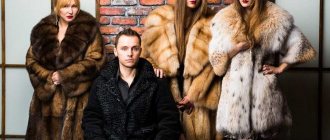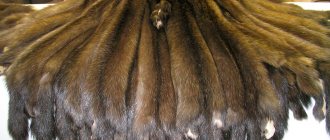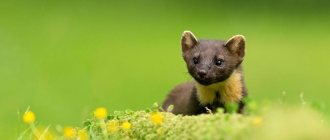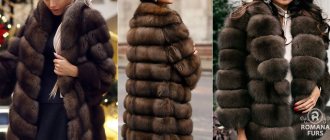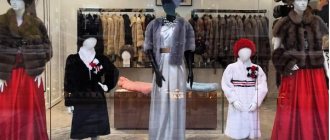In the wild there are a huge number of fur-bearing animals, the fur of which has unique properties, depending on the animal’s membership in a particular biological species. This fur is unique, has distinctive features and coloring. Features of the furs of different types of animals can be seen in Pushnin’s article. Let's get to know each other better. However, even within one species, the properties of fur can vary depending on the habitat of a particular population.
Tobolsk (1), Angara (2), Far Eastern (3), Altai (4), Yenisei (5), Sayan (6), Kuznetsk (7), Yakut (8), Kamchatka (9), Tungus (10), Ilimpisky (11), Barguzinsky (12), Vitimsky (13), Chikoysky (14)
The geographical location of a group of individuals makes adjustments not only to the seasonal habits of the animals, but also to the structure, size and color of the fur. This is best seen in the example of such a rare animal, which has very valuable fur, as the sable.
| The sable is distributed throughout the north of the Eurasian continent and on the Japanese Islands, and each of its populations has its own distinctive characteristics, which can be used to determine exactly where the animal grew up. This also applies to the quality of fur, which has its own characteristics in each population. Sable fur is unique... |
The most obvious qualitative changes in sable fur depending on its habitat can be traced by two characteristics: the color of the fur and the size of the skin. These signs are more susceptible to change than others.
Sable fur. Main characteristics
So, more details. What is sable fur? Its skins are from 15 to 50 centimeters long and from 12 to 30 centimeters wide with different colors. It ranges from light yellow to almost black, depending on individual and geographic variability.
In general, the fur of marten and sable is very similar to each other. The difference in the places where they live together is minimal. However, sable fur is silkier, softer and thicker. In addition, the throat patch of this animal does not extend onto its chest. Its shape is oval or round.
Reproduction
For all mammals of the mustelid family, mating occurs in the warm season (June - July). Babies appear in the spring. The duration of pregnancy is up to 300 days . The female prepares a hollow to nurse her offspring. Lines the home with moss, grass, hay and the hair of rodents that were previously destroyed.
The animals are born small (up to 30 cm in length), deaf and blind. One litter contains from 1 to 7 puppies. Within a month, sables begin to hear , and a little later - to see. In the second month of life, babies begin to be fed meat foods. The young animals begin independent life in the summer, when the female’s next rut begins.
Methods of hunting sable
Hunters set traps for this animal, but they can also hunt with husky dogs. The dogs simply drive the animal into a tree, where the hunter shoots it. But if the animal hides in the thickets, it will be impossible to find it . Then the nets are placed and the animal is driven out using a probe.
Taming the sable and restoring numbers
The animal is quite easy to tame. Very reminiscent of a cat when kept at home. Quickly gets used to household members. In captivity, the animal can live up to 18 years . To preserve mammals, they are bred in nature reserves and then resettled in forest areas. Hunting of animals in these areas is prohibited for a certain period of time.
To determine the location for release of the sable, the presence of food there, nesting sites, enemy predators and the animal’s competitors for food play a role.
Differences
Thus, it becomes clear how the fur of marten and sable differs. The difference, although small, is still there. But sable fur itself also has certain differences. It is divided, for example, into 4 groups. The color of the sable fur influences this.
The first type includes the darkest shades - from dark brown to black. The color of the down is gray-blue or dark blue, uniform along the entire length of the hair.
The second type is brown. The guard hairs of the fur are dark brown, and the down is chestnut on top and blue-gray at the base.
The third type is brown hair, medium dark. Chestnut hair and blue-gray down at the base with light brown tips are its distinctive feature.
And the last, fourth group is the lightest fur. The guard hairs are light brown in color, the down is gray, bluish at the base, with sandy tops.
Furs are divided into groups and ridges depending on the removal and form of editing of the skins. What does it mean?
The first group includes four ridges - Kamchatka (lush, thick, rough fur), Yakut (silkier, medium height), Sakhalin (short, coarse hair) and Amur (small, with low hair growth). These skins are removed using a stocking. The shape of the edit is round.
The second group is the Barguzin ridge. The fur of these skins is very silky, lush and thick. They are removed with a tube. The editing shape is rectangular.
The third group is the Yenisei (medium height, lush, rough fur) and Tobolsk ridges (coarse, thick hair). The skin is removed using a tube. The editing form is semi-long.
And the last group includes three ridges - Minusinsk (thick, silky cover with a short spine), Altai (lush, with a teardrop twisted at the top) and Tuvan (not thick, with high hair). The skins are also removed using a tube. The editing form is long.
Sable economy class
Tobolsk sable
| Tobolsk sable , living in the territory located between the Ural Mountains and the Ob, has a very large size and the lightest fur, which is least valued. Tobolsk sable |
Angarsk sable
| Lives east of the Yenisei Angara sable . It is distributed over a vast territory, including the right bank of the Angara and its tributaries - Podkamennaya Tunguska and Oka, and in the south it reaches the Kansk steppe. Small and light subspecies of sable, which are valued the least. Angarsk sable |
Far Eastern sable
| Far Eastern sable very small and very light, the cheapest subspecies of fur, however, within the subspecies it is divided into three more groups: Sakhalin, Ussuri and Shantar, which have minor differences in the color and size of the skin. It lives throughout the coastal region and on Sakhalin Island. Far Eastern sable |
Twice a year…
In a word, sable fur represents a good variety. The photo of the animal, at the same time, also shows that the animal molts twice a year. In winter, its color is uniformly light due to the many downy hairs. The tail is the same color as the back. Only towards the tip the color darkens slightly. But how does sable fur transform in the summer? The photo shows an animal with low and sparse cover. There is practically no fluff on it. The fur color is generally darker than in winter.
Depending on the time of year, the skins are divided into several groups. The fur, as mentioned, is of course different. In winter, for example, the skin of the first grade is removed from the sable. The fur on it is fully formed - shiny, thick and tall. In late winter, it is possible to obtain first-grade skins with an average defect. The spine on the sides begins to thin out a little, and the hair begins to fade. In autumn, summer and spring, the cover on the skin already shows clear signs of overripeness. The spine becomes even more dull and thins on the sides and nape. By summer the fur is already too low. It grows approximately halfway in mid-autumn. Well, second-grade skins can be obtained in early winter. The fur on them is quite high and thick.
Wild animal behavior
The animal can hunt at any time of the day. He loves to move on the ground. He rarely climbs trees, and only jumps into water as a last resort. He can run over 3 km in a day . The mileage length increases significantly in winter. In search of food, he has to lead a nomadic life. In the summer, he reduces his runs, because there is a chance of stumbling upon a killed large animal.
The animal's tracks in the snow are clearly visible in the photo.
The sable sets aside a section of territory for itself where it hunts for a long period of time. If there is enough food there, the animal will build a hole for itself and tromp paths from the home to the hunting grounds . He builds temporary burrows near large killed animals, narrowing the circle of his movement from the burrow to the feeding site.
In winter, a wild animal knows how to move under a layer of snow. It may not come to the surface for a week, building tunnels in the thickness of the snow cover.
The animal can make nests for itself in hollows and under the roots of large trees, in rocky places.
Stage number one
Where does it all begin? Before obtaining products from sable fur, it is, of course, necessary to first remove the skin. To remove it with a tube, you need to make a cut from the middle toe of one hind paw along its inner side to the toe of the other. The tail is cut along the underside from root to tip. The skin is removed starting from the hind legs. The carcass is hung in different directions, the edges are pulled down. As a result, the skin is removed from the front paws and head. Finally, the lips and nasal cartilage are trimmed.
When skinning with a stocking, the first cuts are made on the head. The carcass is hung from it. The skin shrinks completely. No cuts are made on the paws. At the very end, the tail is cut along the lower surface.
Editing features
The next steps are fleshing and degreasing the resulting skin. Do not forget that in order to obtain beautiful, high-quality products, sable must be processed very carefully. The types of fur influence the chosen editing method. The most suitable rules should be selected for each ridge. The following constructions are most often used.
Elkov straighteners are intended for straightening skins removed with a tube. They give them a rectangular shape.
No less popular is the use of Ignatov’s design. These rules give the skin a long shape. They are, in turn, divided into three types (65, 60 and 55 centimeters in length and, respectively, 10.9, 10 and 9.2 centimeters in width). The width of the planks is 2.5 centimeters, the thickness is 1 centimeter.
To straighten skins removed with stockings, oval-shaped rules are used. Thanks to them, it is possible to achieve an oval shape. The design is also manufactured in three rooms. Length – 48, 40 and 32 centimeters, width – 12, 10 and 8 centimeters.
Quality
How would the consumer like to see sable and mink fur? Of course, high quality, without any defects. However, this is completely impossible, because animals are caught in one of the two most effective ways - by shooting with a gun or using all kinds of self-catchers. Both options, of course, spoil the fur. Guns leave traces of bullet holes, damage hair with bullets and shot, and fur becomes stained with blood. In addition, no one is immune from ruptures from a hunting dog. Self-catchers also lead to some defects. For example, to the absence or damage of paws and fur.
Skins can also suffer if they are removed and processed incorrectly. Considering the considerable cost of this fur, hunters need to be very careful about the processing process. That is, in no case should you allow the formation of tears, incorrect cuts, drafts, etc.
Choosing fur
So, let's go shopping. How to distinguish sable fur from the huge variety presented today in store windows? When is the best time to do this?
Regarding time... If your wardrobe still doesn’t have enough fluffy fur coats, spring is the right time for such a purchase. The cost of furs is falling both in specialized stores and at various fairs. It is even more practical to make such purchases in the summer. However, not many people want to try on furs during the hot season.
Now let's talk more about the sable itself. This “king of furs” can be recognized without much difficulty. Luxurious and expensive - it will be the first to attract the attention of beautiful ladies who want to look chic, feminine, and charming. This fur has been considered a real treasure since the times of ancient Rus'. Under the Tatar-Mongol yoke, it was even included in tribute on the same level as gold. Sable fur was always present in the festive outfits of boyars and princes. Its status did not change over time. Sable fur coats and collars in the Russian Empire demonstrated the size of their owners' wealth. Thus, do not doubt at all that you will see this fur right away. Shiny, rich, soft and thick - it does not remain without the admiring glances of others.
Natural enemies of sable
Animals and birds do not hunt this animal for food. But ermine and weasel compete with sable during the hunt. They also hunt mouse-like rodents . When meeting one of these enemies, the sable is even able to leave its prey in order to destroy its enemy when he turns his attention to food.
The risk group among animals includes old individuals who have lost dexterity and speed of movement, as well as young animals. They can go to any predatory animal that is much larger than them. In addition, sables can be attacked from the air by hawks and owls . On land, they are threatened by lynxes and bears. But the main enemy of the animal is man. He destroys this animal because of its beautiful and expensive fur.
Beauty and sophistication
In a word, sable fur is simply the height of grace and charm. Its description, in addition to beauty, also speaks of wear resistance. It wears well and lasts a long time. Together with the skin, the hair is very tightly connected, so do not doubt at all that the fur will begin to shed after the first season of wear. In terms of wear resistance, sable ranks fourth among its “brothers.” Only otters, beavers and fur seals are ahead of him. Moreover, sable manages to maintain its shine and beauty practically without any additional care. In any case, you will be satisfied with this purchase.
By the way, the Barguzin sable is considered to be the most expensive and, accordingly, the most beautiful. Rich dark brown color with many “gray” hairs gives it a special shine. The Yenisei sable looks a little more modest. There are much fewer “silver” hairs in it, and the main color looks lighter. The cheapest fur (as far as we can talk about) is the so-called Canadian sable. Although experts are most often accustomed to asserting that such an animal does not exist in nature. The fur of marten and sable is very similar in texture. There are not many differences, as mentioned above. Therefore, the marten is simply painted and passed off as sable. Of course, there is no 100% guarantee of the accuracy of this statement. However, this could explain the relatively low cost, and, as experts assure, the dubious quality that is unusual for this fur.
You should also be wary of purchasing products made from “cage” sable. Animals bred in captivity are valued much less, since the quality of their fur is incomparably lower.
How to distinguish sable from marten
Graceful, light and very small animal. His body is very flexible, slightly elongated, and his movements are subtle and graceful. It's all about him - about sable . Its main “wealth” has been worth more than gold for many centuries. Sable fur is a dense and delicate coat. Due to its warm fur and elastic skin, sable products are considered royal.
A relative of the sable and the owner of the same magnificent fur, the marten is increasingly trying to “take away” its status from the luxurious animal. After all, it is marten fur that is most often passed off as expensive sable . Marten fur marten still belongs to elite furs . Fur coats are made from two types of marten - steppe and forest. The steppe marten is slightly larger; this fur is almost never dyed. But the pine marten is most often painted the color of dark sable .
Marten fur has always been a good choice and an excellent alternative to sable. But it’s one thing when you really want to buy a marten fur coat , and another thing when marten fur is specifically passed off as sable.
Despite the amazing similarities between these two types of fur , it is advisable to know all the differences between them. Then buying a fur coat will bring joy and pleasure.
Main "specialists"
And now another question arises: “Which manufacturers of sable fur coats is advisable to purchase?” The main “specialists” for this animal are Italy (HB furs, Mala Mati, Vinicio Pajaro), Russia (Second Furs, Brodski, Claudia).
And, of course, in no case should we forget about the most famous Russian fur designer in the West - Elena Yarmak. It is she who is called the “queen of Russian sable”. Many stars buy her creations. After all, these are in fact real masterpieces.
By the way, she does not advertise her fashion house with every phrase in her speeches. She simply gives good advice to customers. The company must have a good reputation, and the fur must have a certificate. In this case, you will definitely be satisfied with your purchase.



